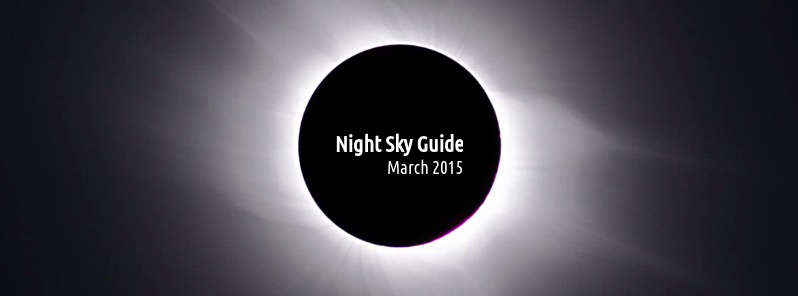Night sky guide for March 2015

With fireball season underway there are many reports of bright fireballs coming in from all over the world, the latest coming from India on February 27. The season will last until April.
Total solar eclipse will occur on March 20 when the Moon will completely block the Sun. The path of totality for this eclipse will be limited to the North Atlantic and Arctic Oceans between Greenland and northern Russia.
On the same day, at 22:45 UTC, March Equinox will occur. The Sun will shine directly on the equator and there will be nearly equal amounts of day and night throughout the world. This is also the first day of spring (vernal equinox) in the Northern Hemisphere and the first day of fall (autumnal equinox) in the Southern Hemisphere.
-
March 3 – IC2602 is well placed. Across much of the world the theta Carinae open star cluster (IC 2602, also known as the southern Pleiades) will be well placed for observation. It will reach its highest point in the sky at around midnight local time. At a declination of -64°24', it is easiest to see from the southern hemisphere and cannot be seen from latitudes much north of 5°N. At magnitude 1.9, IC2602 is visible to the naked eye, but best viewed through a pair of binoculars.
-
March 5 – Full Moon – 18:06 UTC. The Moon will be located on the opposite side of the Earth as the Sun and will be fully illuminated as seen from Earth. This full moon was known by early Native American tribes as the Full Worm Moon because this was the time of year when the ground would begin to soften and the earthworms would reappear. This moon has also been known as the Full Crow Moon, the Full Crust Moon, the Full Sap Moon, and the Lenten Moon.
-
March 6 – Asteroid 7 Iris at opposition. Asteroid 7 Iris will be well placed for observation, lying in the constellation Leo, well above the horizon for much of the night. Regardless of your location on the Earth, Iris will reach its highest point in the sky at around midnight local time.
-
March 9 – NGC 3532 is well placed. Across much of the world the wishing well open star cluster (NGC 3532) in Carina will be well placed for observation. It will reach its highest point in the sky at around midnight local time. At a declination of -58°40', it is easiest to see from the southern hemisphere and cannot be seen from latitudes much north of 11°N. At magnitude 3.0, NGC3532 is tricky to make out with the naked eye except from a dark site, but is visible through a pair of binoculars or small telescope.
-
March 12 – Conjunction between the Moon and Saturn. The Moon and Saturn will make a close approach, passing within 2°13' of each other. At the moment of closest approach, the Moon will be at mag -12.2, and Saturn at mag 1.0, both in the constellation Scorpius. The pair will be too widely separated to fit within the field of view of a telescope, but will be visible to the naked eye or through a pair of binoculars.
-
March 20 – New Moon – 09:36 UTC. The Moon will be located on the same side of the Earth as the Sun and will not be visible in the night sky. This will be the best time of the month to observe faint objects such as galaxies and star clusters because there is no moonlight to interfere.
-
March 20 – Total Solar Eclipse – 09:45 UTC. A total solar eclipse occurs when the Moon completely blocks the Sun, revealing the Sun's beautiful outer atmosphere known as the corona. The path of totality for this eclipse will be limited to the North Atlantic and Arctic Oceans between Greenland and northern Russia. Skywatchers in Europe, northern Africa, and northwestern Asia will be treated to a partial solar eclipse. (NASA Map and Eclipse Information) (NASA Interactive Google Map)
-
March 20 – March Equinox – 22:45 UTC. The Sun will shine directly on the equator and there will be nearly equal amounts of day and night throughout the world. This is also the first day of spring (vernal equinox) in the Northern Hemisphere and the first day of fall (autumnal equinox) in the Southern Hemisphere.

Sources: InTheSky, SeaSky, NASA/Eclipse
Featured image credit: NASA/Goddard. Edit: The Watchers

Commenting rules and guidelines
We value the thoughts and opinions of our readers and welcome healthy discussions on our website. In order to maintain a respectful and positive community, we ask that all commenters follow these rules.